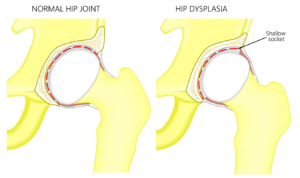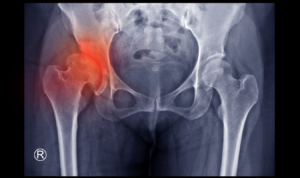
Hip dysplasia is a fairly common condition found in about 1 in 100 newborns. Typically, it is identified and diagnosed upon birth or very early in life. However, some of the more painful and debilitating symptoms of hip dysplasia may not start until a person’s teens or adult years. Thankfully, treatments are available to help. Read on to learn about hip dysplasia, its causes, symptoms, treatments, and more.
 What is hip dysplasia?
What is hip dysplasia?
Hip dysplasia occurs when the hip socket develops abnormally. This causes it to be too shallow to fully cover the ball portion of the hip joint (femoral head). Therefore, the ball is unable to move comfortably within the socket as it should. Thus, the hip joint can easily dislocate and wear out faster than normal. The majority of people with hip dysplasia are born with it and diagnosed early in life.
What are the symptoms of hip dysplasia?
Hip dysplasia symptoms represent a full spectrum of severity, ranging from completely asymptomatic to acute hip dislocations and pain. Often, the symptoms depend on a person’s age. For example, babies may have a leg length discrepancy (one leg that’s longer than the other). Also, hip dysplasia may cause a child to have a limp or experience less flexibility in one hip vs. the other when they start to walk.
Additionally, for teens and adults, hip dysplasia can result in hip and/or groin pain, a ‘clicking’ or ‘popping’ sound and/or feeling in the joint, and in severe cases, recurrent or fixed hip dislocations. Furthermore, patients with hip dysplasia may experience increased pain when they sit or walk for increased periods of time. Often, this pain is located in the front area of the groin. If the condition is not caught until later in life, the patient may experience early onset arthritis or torn cartilage in their teenage or early adult years from improper growth.
What are the risk factors and causes of hip dysplasia?
Females experience hip dysplasia more often than males. Also, the condition occurs more often on the left side of the hip than on the right. Typically, the condition develops in the womb. In addition to prior family history, the following are associated with increased risk for hip dysplasia:
- A large baby in proportion to the size of the mother’s womb
- A mother’s first pregnancy
- Breech position during childbirth
All of the above can reduce the amount of space in the womb. Thus, the lack of room may cause the ball to move out of its appropriate position. Additionally, the improper swaddling of a baby – with their hips and knees straight – can also contribute to the development of this condition.
 How is hip dysplasia diagnosed?
How is hip dysplasia diagnosed?
Most hip dysplasia is identified and diagnosed very early in life by pediatricians through simple range-of-motion testing. Though less common, some are diagnosed with the condition in their teens and adulthood. However, that may require additional diagnostic testing such as x-rays and MRIs.
How is hip dysplasia treated?
Babies and Younger Children
Typically, early hip dysplasia treatments involve nonoperative methods to help allow the hips to develop normally without incident. Some of these include the use of a harness, like a Pavlik Harness, or an abduction brace. In some cases, serial casting may be required. If these non-operative options fail, the doctor may recommend surgery to help keep the developing femoral head inside the developing socket.
Older Children, Teens, and Adults
Once adolescence or adulthood is reached, hip dysplasia treatment options become more limited. Usually, this only option is surgery. However, for many patients, surgery results in a drastic improvement in their quality of life.
For younger patients, hip dysplasia surgery may involve reorienting the socket through a series of pelvic bone cuts (osteotomies). This moves the hip socket so it is in a normal, functional position, allowing the ball to fit more naturally/comfortably within it.
Another treatment option for adult hip dysplasia is a procedure called hip arthroplasty. This involves the placement of a metal implant to reorient the normal socket, in combination with either resurfacing the ball (Birmingham Hip Resurfacing) or resecting the ball (Total Hip Arthroplasty). Although we consider hip arthroplasty procedures as a last-resort treatment option, they reliably improve pain and significantly improve function.
When should I talk to a doctor?
Any condition may worsen and lead to additional complications if left untreated. If you notice your symptoms negatively impact your life, consult an orthopaedic specialist as soon as possible to receive a proper diagnosis and treatment plan.
We can help.
At Advanced Ortho and Spine (AOS), we have extensive knowledge and expertise in treating a wide range of orthopedic conditions, including hip dysplasia. Dr. Christopher Cook, Dr. Michael LaDouceur, and Dr. Lee Swiderek specialize in a variety of orthopaedic treatments and procedures. A few of these include knee and hip replacement surgery, joint resurfacing, complex joint reconstruction, and much more.
Request an appointment online or call us at 615.885.0200 to schedule yours today.
 Dr. Christopher Cook is a Board-Certified Orthopaedic Surgeon and Sports Medicine & Joint Replacement Specialist at Advanced Ortho and Spine. He provides a full spectrum of Joint Replacement, Sports Medicine, and Shoulder & Upper Extremity services. Contact us today for more information or to request an appointment. Contact us today for more information or to request an appointment.
Dr. Christopher Cook is a Board-Certified Orthopaedic Surgeon and Sports Medicine & Joint Replacement Specialist at Advanced Ortho and Spine. He provides a full spectrum of Joint Replacement, Sports Medicine, and Shoulder & Upper Extremity services. Contact us today for more information or to request an appointment. Contact us today for more information or to request an appointment.
 Dr. Lee Swiderek is a Fellowship-Trained Orthopedic Surgeon & Joint Replacement Specialist at Advanced Ortho and Spine. He provides a full spectrum of Joint Replacement and Complex Hip and Knee Reconstruction services. Contact us today for more information or to request an appointment.
Dr. Lee Swiderek is a Fellowship-Trained Orthopedic Surgeon & Joint Replacement Specialist at Advanced Ortho and Spine. He provides a full spectrum of Joint Replacement and Complex Hip and Knee Reconstruction services. Contact us today for more information or to request an appointment.

With two locations near Nashville in Mt. Juliet and Hermitage, Advanced Ortho and Spine provides patients with high-quality, personalized care while advancing orthopaedic excellence. Contact us today to learn more or to schedule your appointment.
Disclaimer: This blog provides general information and discussions about health and related subjects. The information and other content provided in this blog, or in any linked materials, are not intended and should not be construed as medical advice, nor is the information a substitute for professional medical expertise or treatment.If you or any other person has a medical concern, you should consult with your healthcare provider or seek other professional medical treatment. Never disregard professional medical advice or delay in seeking it because of something read on this blog or in any linked materials. If you think you may have a medical emergency, call your doctor or emergency services immediately.
The opinions and views expressed on this blog and website have no relation to those of any academic, hospital, health practice, or other institution.

